User login
IT’S 11 MINUTES to 8 o’clock, and the sun is still climbing over the Potomac River just outside the Gaylord National Resort & Convention Center in National Harbor, Md. Day two of SHM’s annual meeting is about to begin.
Hospitalists file into a cavernous ballroom as the day kicks off with a panel discussion on healthcare reform and a speech by that rarest of breed: a popular hospital CEO. The back of the room fills quickly, but front and center, second row—that’s the seat for Nasim Afsarmanesh, MD, director of quality for HM and neurosurgery at Ronald Reagan UCLA Medical Center in Los Angeles.
“If I’m not in the front, I zone out,” she admits.
Dr. Afsarmanesh (who often adds a hyphen to her surname— Afsar-manesh—to help others pronounce it) knows herself and she knows how to plan ahead, from taking notes on her mini-laptop to knowing when to sit up front. And this day in her life is no different. Her schedule is a 12-hour dervish, yet it’s a simple roadmap of how to navigate HM10 and its scores of sessions, speeches, and seminars.
Innovator at Heart
Dr. Afsarmanesh did her residency in 2007 at UCLA. She stayed on to take a faculty position and is now assistant clinical professor of internal medicine (IM) and neurosurgery. Her days are split about 35% clinical practice, 40% on neurology quality issues, and 25% on hospital QI projects. In her free time, she’s an SHM activist and the incoming chair of its Hospital Quality and Patient Safety (HQPS) Committee.
“I get to be an innovator,” she boasts as she picks up a Danish, a chocolate pastry, and a cup of tea following two hours of listening to others talk. “I love that. You can’t really be an innovator when you’re [purely] practicing clinical medicine.”
Innovation requires preparation, though. Dr. Afsarmanesh spends countless hours creating PowerPoint presentations, so she hit a new feature at this year’s meeting: a limited-seating workshop on drawing up effective slides. The presentation is helpful, but she’s partially distracted. “Look up healthcare from talk,” she types as a note to herself for later. She follows that with “Look up Levy’s talk” (a nod to Paul Levy, the well-liked CEO of Beth Israel Deaconess in Boston).
Facial Recognition
The distraction ratchets up as she’s already looking forward to introducing herself to the editorial board of the Journal of Hospital Medicine, where she serves as an assistant editor. There are a few people she’d like to meet in person, so she gracefully sneaks out the side door a few minutes before noon. Handshakes, a box lunch, and a chat with 40 other journal editors ensue for the next hour.
“You can meet people you talk on the phone with for several years,” she says. “You can put a face to the name. That’s important.”
Hobnobbing at a board meeting is only a brief respite, however, before it’s back to professional development. At 1:15, there’s a 60-minute lesson on how to improve care from the patient perspective. Dr. Afsarmanesh, again, is distracted. She’s a first-time presenter in a few minutes, part of a four-woman panel on building a QI educational curriculum for medical students, residents, fellows, faculty, and other healthcare providers.
She scrolls through slides, rehearsing her thoughts. She wonders whether her PowerPoint presentation would have made the grade at this morning’s session.
She is smart enough not to judge her performance too soon—someone in an audience once reached out to her a year later—as she knows the impact of a training session is more than the round of applause at its end.
“You hope that you generate a discussion more than the traditional didactics,” she says. “These meetings are meant to start a discussion and, hopefully, create a network and a community where people can continue to [share ideas and learn from each other]. … I hope that along with some of the content that people take away, the bigger thing is those connections that they make.”
—Nasim Afsarmanesh, MD, director, HM quality initiatives, Ronald Reagan UCLA Medical Center, Los Angeles
Work Never Ends
It’s 4:30 p.m. and Dr. Afsarmanesh still has a sales pitch to rehearse. This time, it’s self-promotion for her soon-to-begin poster presentation: “The ABCs of Hospitalized Patients: A Multi-Disciplinary Checklist for Improving Quality of Patient Care."
After umpteen repetitions of her spiel, the presentation doesn’t win a prize, but, once again, she showcases her attention to detail: A stack of 8.5”x 11” versions of her poster are available for handouts, a feature few others in the competition have.
Some 12 hours into her tour of this massive convention center, the day is coming to a close. But not before SHM CEO Larry Wellikson, MD, SFHM, drops by to say hello.
He points out how strong her research is. Unfortunately, he uses a pen in the process.
“Don’t poke a hole in my poster,” she jokes.
Moments later, it’s back to working the line queued up at her poster. “Hi, would you like to hear about my poster?” HM2010
Richard Quinn is a freelance writer based in New Jersey.
IT’S 11 MINUTES to 8 o’clock, and the sun is still climbing over the Potomac River just outside the Gaylord National Resort & Convention Center in National Harbor, Md. Day two of SHM’s annual meeting is about to begin.
Hospitalists file into a cavernous ballroom as the day kicks off with a panel discussion on healthcare reform and a speech by that rarest of breed: a popular hospital CEO. The back of the room fills quickly, but front and center, second row—that’s the seat for Nasim Afsarmanesh, MD, director of quality for HM and neurosurgery at Ronald Reagan UCLA Medical Center in Los Angeles.
“If I’m not in the front, I zone out,” she admits.
Dr. Afsarmanesh (who often adds a hyphen to her surname— Afsar-manesh—to help others pronounce it) knows herself and she knows how to plan ahead, from taking notes on her mini-laptop to knowing when to sit up front. And this day in her life is no different. Her schedule is a 12-hour dervish, yet it’s a simple roadmap of how to navigate HM10 and its scores of sessions, speeches, and seminars.
Innovator at Heart
Dr. Afsarmanesh did her residency in 2007 at UCLA. She stayed on to take a faculty position and is now assistant clinical professor of internal medicine (IM) and neurosurgery. Her days are split about 35% clinical practice, 40% on neurology quality issues, and 25% on hospital QI projects. In her free time, she’s an SHM activist and the incoming chair of its Hospital Quality and Patient Safety (HQPS) Committee.
“I get to be an innovator,” she boasts as she picks up a Danish, a chocolate pastry, and a cup of tea following two hours of listening to others talk. “I love that. You can’t really be an innovator when you’re [purely] practicing clinical medicine.”
Innovation requires preparation, though. Dr. Afsarmanesh spends countless hours creating PowerPoint presentations, so she hit a new feature at this year’s meeting: a limited-seating workshop on drawing up effective slides. The presentation is helpful, but she’s partially distracted. “Look up healthcare from talk,” she types as a note to herself for later. She follows that with “Look up Levy’s talk” (a nod to Paul Levy, the well-liked CEO of Beth Israel Deaconess in Boston).
Facial Recognition
The distraction ratchets up as she’s already looking forward to introducing herself to the editorial board of the Journal of Hospital Medicine, where she serves as an assistant editor. There are a few people she’d like to meet in person, so she gracefully sneaks out the side door a few minutes before noon. Handshakes, a box lunch, and a chat with 40 other journal editors ensue for the next hour.
“You can meet people you talk on the phone with for several years,” she says. “You can put a face to the name. That’s important.”
Hobnobbing at a board meeting is only a brief respite, however, before it’s back to professional development. At 1:15, there’s a 60-minute lesson on how to improve care from the patient perspective. Dr. Afsarmanesh, again, is distracted. She’s a first-time presenter in a few minutes, part of a four-woman panel on building a QI educational curriculum for medical students, residents, fellows, faculty, and other healthcare providers.
She scrolls through slides, rehearsing her thoughts. She wonders whether her PowerPoint presentation would have made the grade at this morning’s session.
She is smart enough not to judge her performance too soon—someone in an audience once reached out to her a year later—as she knows the impact of a training session is more than the round of applause at its end.
“You hope that you generate a discussion more than the traditional didactics,” she says. “These meetings are meant to start a discussion and, hopefully, create a network and a community where people can continue to [share ideas and learn from each other]. … I hope that along with some of the content that people take away, the bigger thing is those connections that they make.”
—Nasim Afsarmanesh, MD, director, HM quality initiatives, Ronald Reagan UCLA Medical Center, Los Angeles
Work Never Ends
It’s 4:30 p.m. and Dr. Afsarmanesh still has a sales pitch to rehearse. This time, it’s self-promotion for her soon-to-begin poster presentation: “The ABCs of Hospitalized Patients: A Multi-Disciplinary Checklist for Improving Quality of Patient Care."
After umpteen repetitions of her spiel, the presentation doesn’t win a prize, but, once again, she showcases her attention to detail: A stack of 8.5”x 11” versions of her poster are available for handouts, a feature few others in the competition have.
Some 12 hours into her tour of this massive convention center, the day is coming to a close. But not before SHM CEO Larry Wellikson, MD, SFHM, drops by to say hello.
He points out how strong her research is. Unfortunately, he uses a pen in the process.
“Don’t poke a hole in my poster,” she jokes.
Moments later, it’s back to working the line queued up at her poster. “Hi, would you like to hear about my poster?” HM2010
Richard Quinn is a freelance writer based in New Jersey.
IT’S 11 MINUTES to 8 o’clock, and the sun is still climbing over the Potomac River just outside the Gaylord National Resort & Convention Center in National Harbor, Md. Day two of SHM’s annual meeting is about to begin.
Hospitalists file into a cavernous ballroom as the day kicks off with a panel discussion on healthcare reform and a speech by that rarest of breed: a popular hospital CEO. The back of the room fills quickly, but front and center, second row—that’s the seat for Nasim Afsarmanesh, MD, director of quality for HM and neurosurgery at Ronald Reagan UCLA Medical Center in Los Angeles.
“If I’m not in the front, I zone out,” she admits.
Dr. Afsarmanesh (who often adds a hyphen to her surname— Afsar-manesh—to help others pronounce it) knows herself and she knows how to plan ahead, from taking notes on her mini-laptop to knowing when to sit up front. And this day in her life is no different. Her schedule is a 12-hour dervish, yet it’s a simple roadmap of how to navigate HM10 and its scores of sessions, speeches, and seminars.
Innovator at Heart
Dr. Afsarmanesh did her residency in 2007 at UCLA. She stayed on to take a faculty position and is now assistant clinical professor of internal medicine (IM) and neurosurgery. Her days are split about 35% clinical practice, 40% on neurology quality issues, and 25% on hospital QI projects. In her free time, she’s an SHM activist and the incoming chair of its Hospital Quality and Patient Safety (HQPS) Committee.
“I get to be an innovator,” she boasts as she picks up a Danish, a chocolate pastry, and a cup of tea following two hours of listening to others talk. “I love that. You can’t really be an innovator when you’re [purely] practicing clinical medicine.”
Innovation requires preparation, though. Dr. Afsarmanesh spends countless hours creating PowerPoint presentations, so she hit a new feature at this year’s meeting: a limited-seating workshop on drawing up effective slides. The presentation is helpful, but she’s partially distracted. “Look up healthcare from talk,” she types as a note to herself for later. She follows that with “Look up Levy’s talk” (a nod to Paul Levy, the well-liked CEO of Beth Israel Deaconess in Boston).
Facial Recognition
The distraction ratchets up as she’s already looking forward to introducing herself to the editorial board of the Journal of Hospital Medicine, where she serves as an assistant editor. There are a few people she’d like to meet in person, so she gracefully sneaks out the side door a few minutes before noon. Handshakes, a box lunch, and a chat with 40 other journal editors ensue for the next hour.
“You can meet people you talk on the phone with for several years,” she says. “You can put a face to the name. That’s important.”
Hobnobbing at a board meeting is only a brief respite, however, before it’s back to professional development. At 1:15, there’s a 60-minute lesson on how to improve care from the patient perspective. Dr. Afsarmanesh, again, is distracted. She’s a first-time presenter in a few minutes, part of a four-woman panel on building a QI educational curriculum for medical students, residents, fellows, faculty, and other healthcare providers.
She scrolls through slides, rehearsing her thoughts. She wonders whether her PowerPoint presentation would have made the grade at this morning’s session.
She is smart enough not to judge her performance too soon—someone in an audience once reached out to her a year later—as she knows the impact of a training session is more than the round of applause at its end.
“You hope that you generate a discussion more than the traditional didactics,” she says. “These meetings are meant to start a discussion and, hopefully, create a network and a community where people can continue to [share ideas and learn from each other]. … I hope that along with some of the content that people take away, the bigger thing is those connections that they make.”
—Nasim Afsarmanesh, MD, director, HM quality initiatives, Ronald Reagan UCLA Medical Center, Los Angeles
Work Never Ends
It’s 4:30 p.m. and Dr. Afsarmanesh still has a sales pitch to rehearse. This time, it’s self-promotion for her soon-to-begin poster presentation: “The ABCs of Hospitalized Patients: A Multi-Disciplinary Checklist for Improving Quality of Patient Care."
After umpteen repetitions of her spiel, the presentation doesn’t win a prize, but, once again, she showcases her attention to detail: A stack of 8.5”x 11” versions of her poster are available for handouts, a feature few others in the competition have.
Some 12 hours into her tour of this massive convention center, the day is coming to a close. But not before SHM CEO Larry Wellikson, MD, SFHM, drops by to say hello.
He points out how strong her research is. Unfortunately, he uses a pen in the process.
“Don’t poke a hole in my poster,” she jokes.
Moments later, it’s back to working the line queued up at her poster. “Hi, would you like to hear about my poster?” HM2010
Richard Quinn is a freelance writer based in New Jersey.



